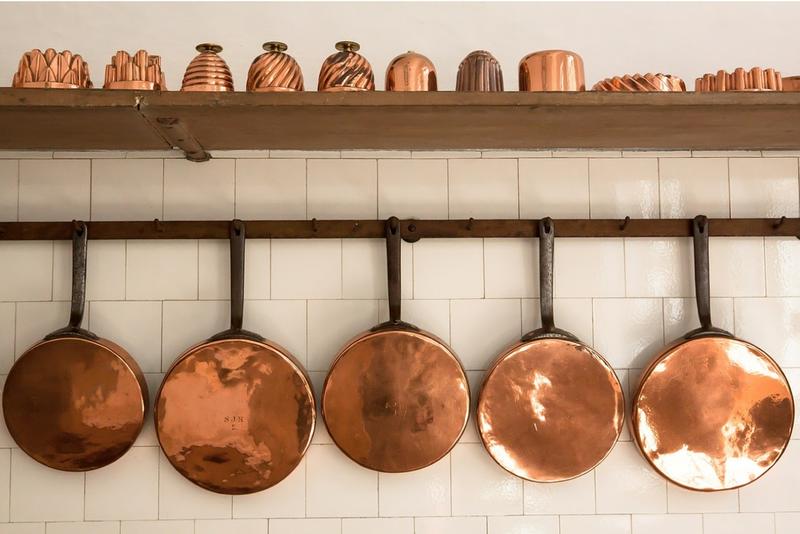Easy Ways to Get the Metal From Around the Copper Wire

Copper is a versatile metal with plenty of uses. You may be surprised how often copper appears in items that you use every day. It may not be the main material in those items, but a wide variety of things that you encounter regularly contain at least a small amount of copper.
Kitchen Items
The flatware you use at your kitchen table most likely contains copper. Silver-plated flatware is made from an alloy of copper, nickel, and zinc, and a 12-piece silver-plated set of flatware contains about 1.2 pounds of copper. Sterling silver tableware contains about 7.5 percent copper to make it stronger.
Cookware has been made with copper for generations. You'll probably see a lot of antique copper cookware if you look around older homes, and modern cookware contains copper as well. Professional chefs prefer copper because it transfers heat well, and many items for cooking contain at least a small amount of copper today. If you have any of the popular "clad" cookware, it features copper on the bottom of the pots and pans clad between sheets of aluminum or stainless steel.
B rass Items
Brass is an alloy made from copper and zinc, and it's used in all kinds of everyday items. Things that you see around your house that are made of brass naturally contain copper. A set of brass fireplace tools contains 10 pounds of copper, and a fireplace screen made of brass uses 12 pounds of copper. Brass lamps contain about seven pounds of copper. Clocks and watches contain copper because it's not a magnetic metal and won't interfere with timekeeping.
Of course, brass is used in various musical instruments as well. Copper is antibacterial and resists corrosion, so you'll see it used to make brass instruments like trumpets, trombones, saxophones, and other types of horns. Don't forget other brass items around the house, from doorknobs to faucets to brass beds and mirror frames. Anywhere you see brass, you'll find copper.
C onstruction Materials
You might be surprised at how much of the materials used to build your home contain copper. Copper is a flexible yet stable material that resists corrosion and heat, which is why it's a popular material in all sorts of construction applications. Many of the pipes in your plumbing system are copper, and if you have a sprinkler system, it's likely made from copper too.
Copper is often used in nails, staples, and screws as well as in the power tools that fasten them to wood and metal. You can also find it in your air conditioning and heating system because it's such a good conductor of heat. You'll even find copper in many of the fixtures around your house, from the kitchen to the bathroom to the locks and hinges inside and out.
E lectronics
Copper is one of the most common items in electronics. Nearly all electrical wiring has copper in it, and the only exception is overhead power lines, which use aluminum because it's lighter than copper. Transformers, conductors, and motors use copper because of its efficiency. Cables for your television and other electronic devices use copper, and you'll find it in headphone cables, speaker wires, USB cables, and much more.
Copper is also an important component in other types of wiring as well. Your cable box and the cables that connect from the TV to the wall have copper in them. Your internet modem and the cables that get data to and from your house or workplace contain copper as well.
T ransportation
Much of the transportation industry runs on items made from copper. In your cars, the climate control and defrost systems largely consist of copper. Conveniences like heated seats and safety features like antilock brakes rely on copper as well. Radiators are mostly copper and brass. Even electric cars contain large amounts of copper ― roughly 55 pounds of it. Even jumper cables are made in part from copper.
A commercial airplane contains about 118 miles of copper wiring while high-speed trains run on tracks that include large amounts of copper. Components in ships are made from copper or brass as well.
C oins
Although today's coins don't contain the amount of copper that older coins once did, there's still a small amount of copper in the coins in your pocket. Pennies consisted of 95 percent copper until 1982, but today only about 2.5 percent of a one-cent piece is made of copper. Other coins contain trace amounts of copper, but older coins had a larger concentration of copper, which contributes to the value of older coins.
Source: https://www.reference.com/science/things-made-out-copper-715c7ff1badb832f?utm_content=params%3Ao%3D740005%26ad%3DdirN%26qo%3DserpIndex&ueid=dbc90fa9-865d-47bc-9e73-ffa605a89456
0 Response to "Easy Ways to Get the Metal From Around the Copper Wire"
Post a Comment